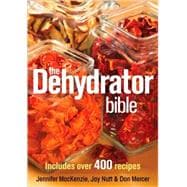
Note: Supplemental materials are not guaranteed with Rental or Used book purchases.
Purchase Benefits
What is included with this book?
Jennifer MacKenzie is a professional home economist specializing in recipe development and testing.
Jay Nutt is a chef and owns a gourmet food store.
Don Mercer is a professional engineer and associate professor in the Department of Food Science at the University of Guelph, Canada.
| Introduction | |
| Acknowledgments | |
| Dehydrating Foods | |
| Everything You Need to Know About Dehydrating Foods | |
| Dehydrating Fresh Produce | |
| Making Fruit and Vegetable Leathers | |
| Dehydrating Beans, Tofu, Grains and Dairy | |
| Dehydrating Meat, Poultry and Fish | |
| Cooking at Home with Dehydrating Foods | |
| Using Dehydrated Foods in Everyday Cooking | |
| Breakfast | |
| Soups | |
| One-Dish Meals | |
| Side Dishes | |
| Salad Dressings, Sauces and Fillings | |
| Snacks | |
| Baked Goods | |
| Desserts | |
| Cooking on the Trail with Dehydrated Foods | |
| Everything You Need to Know About Camp Food | |
| Breakfast | |
| Main Courses | |
| Side Dishes and Accompaniments | |
| Snacks, Baked Goods and Desserts | |
| Other Uses for Your Dehydrator | |
| Pet Treats | |
| Gifts | |
| Crafts | |
| Appendix: Dorm Room Cuisine | |
| Index | |
| Table of Contents provided by Publisher. All Rights Reserved. |
The New copy of this book will include any supplemental materials advertised. Please check the title of the book to determine if it should include any access cards, study guides, lab manuals, CDs, etc.
The Used, Rental and eBook copies of this book are not guaranteed to include any supplemental materials. Typically, only the book itself is included. This is true even if the title states it includes any access cards, study guides, lab manuals, CDs, etc.